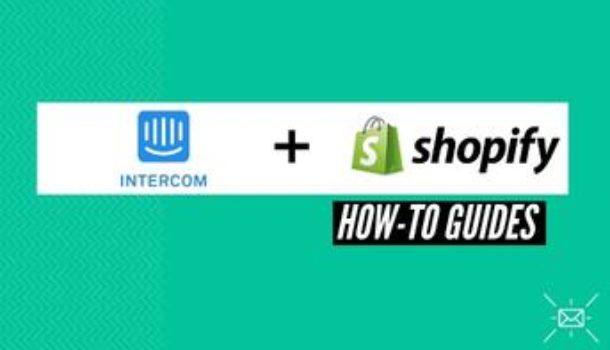Your Shopify store offers a one-stop selling solution that helps to make it easy to run your business. However, to further enhance revenue and sales generation, you want to pair the store with a powerful customer relationship management and communication platform. The Intercom Shopify plugin integration can help you achieve this.
Yet, to appreciate this integration and make full use of it, you want to first know what exactly Intercom does. The Intercom platform is a conversational relationship tool designed to track your customers based on their engagement and make it easy to communicate with them. The tool allows you to engage your customer through targeted content, behavior driven messages, and conversational support.
What makes this platform resourceful for your online store is that it offers an all solution stop – it helps you track, understand, communicate with, and support your customers, and visitors. Therefore, to help you take your online Shopify store to the next level – we’ve outlined a brief, yet, detailed guideline of how to seamlessly execute the Intercom Shopify integration.
Key Intercom Features
We’ve already established that the Intercom platform significantly boosts your online store. However, this platform is packed with other unique features that further enhance the integration. These features include contact syncing, attribute mapping, confirmation forms, and even site tracking.
Contact Sync
Intercom offers contact synching – allowing you to copy your contacts from your Shopify store to your Intercom contacts. The syncing process makes it easy to manage your communication in one place with simplified workflows. However, Intercom also comes with another special mechanism that is unlike other platforms.
Whilst connected to Shopify, it allows your customers to easily solve their problems and even check the status of their orders. All they have to do is enter their email address or order number and they can check their status. This process allows you to significantly cut down inquiry volumes whilst ensuring all your customers are well taken care of.
Attribute Mapping
Intercom is built with an effective data attribute feature – allowing you to create and track data about your customer and leads based on the criteria you set. The data you garner using this feature helps you to accurately segment your customer lists and send targeted messages/campaigns. Additionally, the data can also be used for lead generations. Typically, you can track data such as purchase values, subscription dates, or even pricing plans.
Single/Double Opt-in confirmation
The Intercom platform offers a default double opt-in confirmation – meaning that a potential subscriber needs to go through to layers of confirmation – sign up sheet and email confirmation to be added to the list. This form of confirmation comes with the advantage of reducing the chances that your campaigns and messages will end up as spam.
On the other end, it also proves your customer’s commitment to the product/service you are selling – very few people will go through the trouble for a service/product they don’t need. Furthermore, the double opt-in confirmation is a mandatory setting for websites in some countries – widening the site’s usability.
Tracking
Intercom boasts a comprehensive site tracking design. You can set the tracking mechanism based on the data you want. Intercom tracking allows you to track your customer’s engagement and activities while they are logged into the product and/or when visiting the site.
The site tracker monitors and records events the first, last, and number of times the customer takes an action. With the tracking, you don’t only get data to better understand your business. You can even filter the recorded data to segment your customers and send auto messages based on the actions.
At higher plans, you can further narrow the data segmentation to get both overall data and focus on a single customer/smaller event. To help you get a head start, as soon as you sign up for the platform, you will be given a list of user attributes on the left side of the screen – offering more than 15 data types to work with.
How To Set Up The Integration
You can integrate your Shopify store with intercom through three easy methods – i.e. via Intercom site, Zapier, or Automate.io. The intercom site is the most commonly used option.
To execute the installation using the intercom site, follow the steps below;
- Sign up for the Intercom platform
- Go to the Intercom app store and select Shopify – and click Install now
- Enter your Shopify store URL on the URL line ( your Shopify account should be logged in)
- To allow the Intercom connection in your Shopify store, click on Update unlisted app
- This will redirect you to the Intercom so you can also authorize the Shopify access – at the bottom, click on Authorize access
- Once done, the intercom icon will appear at the right bottom side of your Shopify store
Similarly, you can connect Intercom and Shopify using Zapier or Automate.io if you have an account with these platforms. The best part about choosing these platforms is that they work for people who want to choose what to add to the integration. The integration works by pre-selecting triggers (from Intercom) and action events (for Shopify). They offer more custom integration.
If you choose to integrate the store and Intercom through the intercom site, you can enjoy a free trial. The intercom Shopify integration free trial lasts up to 14 days. After that, it turns into a monthly payment plan. However, it only costs $4.90 per month.
Alternatively, if you want to go for the integration through the third party apps, you can opt for their plans which give you access to multiple integrations – The intercom and Shopify plugin is one of them. Whilst the platforms offer free trial plans, they have payment plans after the fact as well. The cost ranges from 19.99 to $299 per month depending n the plan you choose.
Comparison With Other Shopify Integrations
When compared to alternative platforms, intercom Shopify integration boasts its own unique features. Whilst the integration is paid for, it is still one the cheapest options amongst paid integrations.
Furthermore, the integration offers three easy methods to enjoy – whether you want to enjoy a full native integration or customize it based on your needs through Zapier or Autmate.io. However, what makes the intercom integration with Shopify special are the diverse features it offers.
The platform offers more comprehensive customer engagement tools by allowing you to automate the customer support for your online store – ensuring all your customers are taken care of simultaneously. This means that visiting your website doesn’t waste their time and guarantees consistency when it comes to customer support.
On your end, it helps to smoothen your workflows – leaving you with enough time to focus on the back end needs. The integration offers an impressive customer synching and site tracking ability too. Compared to the Intercom integration with Shopify, the Drip Shopify integration is more costly. This paid integration costs a minimum of $19 per month.
However, similarly to Intercom, it offers a 14-day trial as well. Whilst the intercom platform focuses on live chat and conversational customer relationship – Drip is a little different. This platform focuses on CRM and multi-channel marketing. But, it also offers workflow automation, personalized email campaigns, and customer activity reporting too.
Drip is also designed to allow unique customization for purchase driven and loyalty-building emails in its visual email builder whilst allowing you to include product recommendations on the emails. Amongst the popular Drip workflow feature options include cart abandonment, abandon browse, and celebrating loyal customer email campaigns.
The Mailerlite integration with Shopify offers a 14-day free trial. However, it is even more expensive compared to the Intercom integration. The Mailerlite integration offers an option of three pricing plans. The basic plan costs $29 per month whilst the medium and advanced plans cost $79 and $299 per month, respectively.
The Mailerlite free plan is not available for Shopify integrations, however. The Mailerlite Shopify integration offers key features such as sales tracking, product importing, and automation triggers based on customer purchase activity. But, unlike Intercom, the different price plans offered vary in features. Whilst the advanced plan is rich in additional features, the basic plan boasts minimal features.
Yet, the price plan tiers come with an advantage too – preventing you from overpaying! You only pay for the number of subscribers your business has. To encourage more customer subscriptions, Mailerlite offers a special subscribe pop up feature to encourage newsletter and promotion sign ups.
Conclusion
No doubt using the Intercom Shopify integration adds value to your online business. Whilst it helps with workflow automations for the store, it also supports superior conversation customer relationship management. The best part about the integration is
the fact that you receive these interactive features while paying significantly low for the service.
This makes the integration great even for small startups that are looking to draw in more customers through their customer support and marketing. But, as with any service, Intercom may lack in other email marketing areas where platforms such as Mailerlite and Drip can compensate. But, these platforms are nearly four times the cost of the Intercom integration. So, your decision on integration options depends on your budget and the needs of your business.

